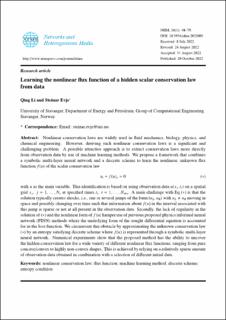| dc.contributor.author | Li, Qing | |
| dc.contributor.author | Evje, Steinar | |
| dc.date.accessioned | 2023-09-08T12:00:09Z | |
| dc.date.available | 2023-09-08T12:00:09Z | |
| dc.date.created | 2022-10-23T20:55:48Z | |
| dc.date.issued | 2023-10 | |
| dc.identifier.citation | Li, Q. & Evje, S. (2023) Learning the nonlinear flux function of a hidden scalar conservation law from data. Networks and Heterogeneous Media, 18 (1), 48-79. | en_US |
| dc.identifier.issn | 1556-1801 | |
| dc.identifier.uri | https://hdl.handle.net/11250/3088309 | |
| dc.description.abstract | Nonlinear conservation laws are widely used in fluid mechanics, biology, physics, and chemical engineering. However, deriving such nonlinear conservation laws is a significant and challenging problem. A possible attractive approach is to extract conservation laws more directly from observation data by use of machine learning methods. We propose a framework that combines a symbolic multi-layer neural network and a discrete scheme to learn the nonlinear, unknown flux function f(u) of the scalar conservation law
ut + f(u)x = 0 *
with u as the main variable. This identification is based on using observation data u(xj,ti) on a spatial grid xj, j = 1, ... Nx at specified times ti, i = 1, ..., Nobs.
A main challenge with Eq (*) is that the solution typically creates shocks, i.e., one or several jumps of the form (uL, uR) with uL ≠ uR moving in space and possibly changing over time such that information about f(u) in the interval associated with this jump is sparse or not at all present in the observation data. Secondly, the lack of regularity in the solution of (*) and the nonlinear form of f(u) hamper use of previous proposed physics informed neural network (PINN) methods where the underlying form of the sought differential equation is accounted for in the loss function. We circumvent this obstacle by approximating the unknown conservation law (*) by an entropy satisfying discrete scheme where f(u) is represented through a symbolic multi-layer neural network. Numerical experiments show that the proposed method has the ability to uncover the hidden conservation law for a wide variety of different nonlinear flux functions, ranging from pure concave/convex to highly non-convex shapes. This is achieved by relying on a relatively sparse amount of observation data obtained in combination with a selection of different initial data. | en_US |
| dc.language.iso | eng | en_US |
| dc.publisher | American Institute of Mathematical Sciences (AIMS) Press | en_US |
| dc.rights | Navngivelse 4.0 Internasjonal | * |
| dc.rights.uri | http://creativecommons.org/licenses/by/4.0/deed.no | * |
| dc.subject | heterogene media | en_US |
| dc.subject | maskinlæring | en_US |
| dc.title | Learning the nonlinear flux function of a hidden scalar conservation law from data | en_US |
| dc.type | Peer reviewed | en_US |
| dc.type | Journal article | en_US |
| dc.description.version | publishedVersion | en_US |
| dc.rights.holder | © 2023 licensee AIMS Press | en_US |
| dc.subject.nsi | VDP::Matematikk og Naturvitenskap: 400::Matematikk: 410 | en_US |
| dc.source.pagenumber | 48-79 | en_US |
| dc.source.volume | 18 | en_US |
| dc.source.journal | Networks and Heterogeneous Media | en_US |
| dc.source.issue | 1 | en_US |
| dc.identifier.doi | 10.3934/nhm.2023003 | |
| dc.identifier.cristin | 2064073 | |
| cristin.ispublished | true | |
| cristin.fulltext | original | |
| cristin.qualitycode | 2 | |

